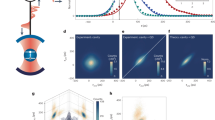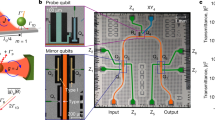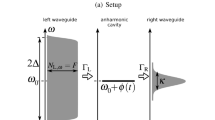Abstract
At low temperatures, sufficiently small metallic1 and semiconductor2 devices exhibit the ‘Coulomb blockade’ effect, in which charge transport through the device occurs on an electron-by-electron basis3. For example, a single electron on a metallic island can block the flow of another electron if the charging energy of the island greatly exceeds the thermal energy. The analogous effect of ‘photon blockade’ has been proposed for the transport of light through an optical system; this involves photon–photon interactions in a nonlinear optical cavity4,5,6,7,8,9,10,11,12,13. Here we report observations of photon blockade for the light transmitted by an optical cavity containing one trapped atom, in the regime of strong atom–cavity coupling14. Excitation of the atom–cavity system by a first photon blocks the transmission of a second photon, thereby converting an incident poissonian stream of photons into a sub-poissonian, anti-bunched stream. This is confirmed by measurements of the photon statistics of the transmitted field. Our observations of photon blockade represent an advance over traditional nonlinear optics and laser physics, into a regime with dynamical processes involving atoms and photons taken one-by-one.
This is a preview of subscription content, access via your institution
Access options
Subscribe to this journal
Receive 51 print issues and online access
$199.00 per year
only $3.90 per issue
Buy this article
- Purchase on Springer Link
- Instant access to full article PDF
Prices may be subject to local taxes which are calculated during checkout



Similar content being viewed by others
References
Fulton, T. A. & Dolan, G. J. Observation of single-electron charging effects in small tunnel junctions. Phys. Rev. Lett. 59, 109–112 (1987)
Kastner, M. A. The single-electron transistor. Rev. Mod. Phys. 64, 849–858 (1992)
Likharev, K. K. Single-electron devices and their applications. Proc. IEEE 87, 606–632 (1999)
Tian, L. & Carmichael, H. J. Quantum trajectory simulations of two-state behavior in an optical cavity containing one atom. Phys. Rev. A 46, R6801 (1992)
Imamoḡlu, A., Schmidt, H., Woods, G. & Deutsch, M. Strongly interacting photons in a nonlinear cavity. Phys. Rev. Lett. 79, 1467–1470 (1997)
Grangier, P., Walls, D. F. & Gheri, K. M. Comment on “Strongly interacting photons in a nonlinear cavity”. Phys. Rev. Lett. 81, 2833 (1998)
Werner, M. J. & Imamoḡlu, A. Photon-photon interactions in cavity electromagnetically induced transparency. Phys. Rev. A 61, 011801 (1999)
Rebić, S., Tan, S. M., Parkins, A. S. & Walls, D. F. Large Kerr nonlinearity with a single atom. J. Opt. B 1, 490–495 (1999)
Rebić, S., Parkins, A. S. & Tan, S. M. Polariton analysis of a four-level atom strongly coupled to a cavity mode. Phys. Rev. A 65, 043806 (2002); Photon statistics of a single-atom intracavity system involving electromagnetically induced transparency. Phys. Rev. A 65, 063804 (2002)
Kim, J., Bensen, O., Kan, H. & Yamamoto, Y. A single-photon turnstile device. Nature 397, 500–503 (1999)
Smolyaninov, I. I., Zayats, A. V., Gungor, A. & Davis, C. C. Single-photon tunneling via localized surface plasmons. Phys. Rev. Lett. 88, 187402 (2002)
Brecha, R. J., Rice, P. R. & Xiao, M. N two-level atoms in a driven optical cavity: quantum dynamics of forward photon scattering for weak incident fields. Phys. Rev. A 59, 2392–2417 (1999)
Hood, C. J. Real-time Measurement and Trapping of Single Atoms by Single Photons. Section 6.2. PhD dissertation, California Institute of Technology (2000)
Kimble, H. J. Strong interactions of single atoms and photons in cavity QED. Phys. Scr. T76, 127–138 (1998)
Jaynes, E. T. & Cummings, F. W. Comparison of quantum and semiclassical radiation theories with application to the beam maser. Proc. IEEE 51, 89–109 (1963)
Kimble, H. J., Dagenais, M. & Mandel, L. Photon antibunching in resonance fluorescence. Phys. Rev. Lett. 39, 691–695 (1977)
Mandel, L. & Wolf, E. Optical Coherence and Quantum Optics (Cambridge Univ. Press, Cambridge, 1995)
McKeever, J. et al. State-insensitive cooling and trapping of single atoms in an optical cavity. Phys. Rev. Lett. 90, 133602 (2003)
Carmichael, H. J., Brecha, R. J. & Rice, P. R. Quantum interference and collapse of the wavefunction in cavity QED. Opt. Commun. 82, 73–79 (1991)
Carmichael, H. J. Photon antibunching and squeezing for a single atom in a resonant cavity. Phys. Rev. Lett. 55, 2790–2793 (1985)
Boca, A. et al. Observation of the vacuum Rabi spectrum for one trapped atom. Phys. Rev. Lett. 93, 233603 (2004)
McKeever, J. et al. Deterministic generation of single photons from one atom trapped in a cavity. Science 303, 1992–1994 (2004)
Diedrich, F. & Walther, H. Nonclassical radiation of a single stored ion. Phys. Rev. Lett. 58, 203–260 (1987)
Acknowledgements
We gratefully acknowledge the contributions of J. McKeever and C. J. Hood. This research is supported by the National Science Foundation, by the Caltech MURI Center for Quantum Networks, and by the Advanced Research and Development Activity (ARDA).
Author information
Authors and Affiliations
Corresponding author
Ethics declarations
Competing interests
Reprints and permissions information is available at npg.nature.com/reprintsandpermissions. The authors declare no competing financial interests.
Supplementary information
Supplementary Notes
The text of our Supplementary Information, describing thet the coupling used in the model Hamiltonian to determine the eigenvalues displayed in Fig. 1b of the main text. This file also contains Supplementary Figure S1 and Supplementary Figure S2. (PDF 160 kb)
Rights and permissions
About this article
Cite this article
Birnbaum, K., Boca, A., Miller, R. et al. Photon blockade in an optical cavity with one trapped atom. Nature 436, 87–90 (2005). https://doi.org/10.1038/nature03804
Received:
Accepted:
Issue Date:
DOI: https://doi.org/10.1038/nature03804
This article is cited by
-
Room-temperature strong coupling in a single-photon emitter-metasurface system
Nature Communications (2024)
-
Conventional and Unconventional Photon Blockade in a Double-Cavity Optomechanical System
Brazilian Journal of Physics (2024)
-
Applications of single photons to quantum communication and computing
Nature Reviews Physics (2023)
-
A subwavelength atomic array switched by a single Rydberg atom
Nature Physics (2023)
-
Strong photon antibunching effect in a double-cavity optomechanical system with intracavity squeezed light
Quantum Information Processing (2023)
Comments
By submitting a comment you agree to abide by our Terms and Community Guidelines. If you find something abusive or that does not comply with our terms or guidelines please flag it as inappropriate.



